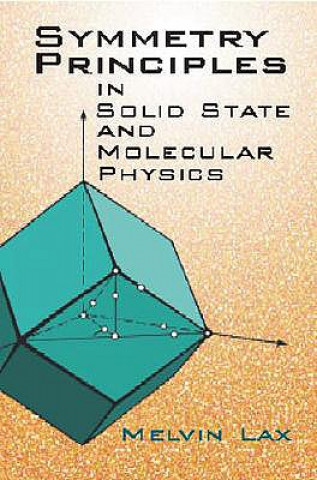
Doručení
Nákupní rádce





Nehodí se? Vůbec nevadí! U nás můžete do 30 dní vrátit
 Dárkový poukaz
V libovolné hodnotě
Dárkový poukaz
V libovolné hodnotě
S dárkovým poukazem nešlápnete vedle. Obdarovaný si za dárkový poukaz může vybrat cokoliv z naší nabídky.
Symmetry Principles in Solid State
 Angličtina
Angličtina
 55 b
55 b
30 dní na vrácení zboží
Mohlo by vás také zajímat


Chapter 1. Relation of Group Theory to Quantum mechanics 1.1 Symmetry Operations 1.2 Abstract Group Theory 1.3 Commuting Observables and Classes 1.4 Representations and Irreducible Representations 1.5 Relation between Representations, Characters, and States 1.6 Continuous Groups 1.7 Summary Chapter 2. Point Groups 2.1 Generators of the Proper Rotation Group R superscript + (3) 2.2 The Commutator Algebra of R superscript + (3) 2.3 Irreducible Representations of R superscript + (3) 2.4 Characters of the Irreducible Representations of R superscript + (3) 2.5 The Three-dimensional Representation j=1 of R superscript + (3) 2.6 The Spin Representation j=1/2 of R superscript + (3) 2.7 Class Structure of Point Groups 2.8 The Proper Point Groups 2.9 Nature of Improper Rotations in a Finite Group 2.10 Relation between Improper and Proper Groups 2.11 Representations of Groups Containing the Inversion 2.12 Product Groups 2.13 Representations of an Outer Product Group 2.14 Enumeration of the Improper Point Groups 2.15 Crystallographic Point Groups 2.16 Double Point Groups 2.17 Summary Chapter 3. Point Group Examples 3.1 Electric and Magnetic Dipoles: Irreducible Components of a Reducible Space 3.2 Crystal field Theory without Spin: Compatibility Relations 3.3 Product Representations and Decomposition of Angular Momentum 3.4 Selection rules 3.5 Spin and Spin-Orbit Coupling 3.6 Crystal Field Theory with Spin 3.7 Projection Operators 3.8 Crystal Harmonics 3.9 Summary Chapter 4. Macroscopic Crystal Tensors 4.1 Macroscopic Point Group Symmetry 4.2 Tensors of the First Rank: Ferroelectrics and Ferromagnetics 4.3 Second-Rank Tensors: Conductivity, Susceptibility 4.4 Direct Inspection Methods for Tensors of Higher Rank: the Hall Effect 4.5 Method of Invariants 4.6 Measures of Infinitesimal and Finite Strain 4.7 The Elasticity Tensor for Group C subscript (3upsilon) 4.8 Summary Chapter 5. Molecular Vibrations 5.1 Representations contained in NH subscript 3 vibrations 5.2 Determination of the Symmetry Vectors for NH subscript 3 5.3 Symmetry Coordinates, Normal Coordinates, Internal Coordinates, and Invariants 5.4 Potential Energy and Force Constants 5.5 The Number of Force Constants 5.6 Summary Chapter 6. Translational Properties of Crystals 6.1 Crystal Systems, Bravais Lattices, and Crystal Classes 6.2 Representations of the Translation Group 6.3 Reciprocal Lattices and Brillouin Zones 6.4 Character Orthonormality Theorems 6.5 Conservation of Crystal Momentum 6.6 Laue-Bragg X-ray Diffraction 6.7 Summary Chapter 7. Electronic Energy Bands 7.1 Relation between the Many-Electron and One-Electron Viewpoints 7.2 Concept of an Energy Band 7.3 The Empty Lattice 7.4 Almost-Free Electrons 7.5 Energy Gaps and Symmetry Considerations 7.6 Points of Zero Slope 7.7 Periodicity in Reciprocal Space 7.8 The k • p Method of Analytical Continuation 7.9 Dynamics of Electron Motion in Crystals 7.10 Effective Hamiltonians and Donor States 7.11 Summary Chapter 8. Space Groups 8.1 Screw Axes and Glide Planes 8.2 Restrictions on space Group Elements 8.3 Equivalence of Space Groups 8.4 Construction of Space Groups 8.5 Factor Groups of Space Groups 8.6 Groups G subscript k of the Wave Vector k 8.7 Space Group Algebra 8.8 Representations of Symmorphic Space Groups 8.9 Representations of Nonsymmorphic Space Groups 8.10 Class Structure and Algebraic Treatment of Multiplier Groups 8.11 Double Space Groups 8.12 Summary Chapter 9. Space Group Examples 9.1 Vanishing Electric Moment in Diamond 9.2 Induced Quadrupole Moments in Diamond 9.3 Force Constants in Crystals 9.4 Local Electric Moments 9.5 Symmetries of Acoustic and Optical Modes of Vibration 9.6 Hole Scattering by Phonons 9.7 Selection Rules for Direct Optical Absorption 9.8 Summary Chapter 10. Time reversal 10.1 Nature of Time-Reversal Operators without Spin 10.2 Time Reversal with Spin 10.3 Time Reversal in External Fields 10.4 Antilinear and Antiunitary Operators 10.5 Onsager Relations 10.6 The Time-Reversed Representation 10.7 Time-reversal Degeneracies 10.8 The Herring Criterion for Space Groups 10.9 Selection Rules Due to Time Reversal 10.10 Summary Chapter 11. Lattice Vibration Spectra 11.1 Inelastic Neutron Scattering 11.2 Transformation to Normal Coordinates 11.3 Quantized Lattice Oscillators: Phonons 11.4 Crystal Momentum 11.5 Infinitesimal Displacement and Rotational Invariance 11.6 Symmetry Properties of the Dynamical Matrix 11.7 Consequences of Time Reversal 11.8 Form and Number of Independent Constants in the Dynamical Matrix for Internal and Zone Boundary Points 11.9 The Method of Long Waves: Primitive Lattices 11.10 Nonprimitive Lattices and Internal Shifts 11.11 Summary Chapter 12. Vibrations of Lattices with the Diamond Structure 12.1 Force Constants and the Dynamical Matrix 12.2 Symmetry of Vibrations at DELTA = (q, 0, 0) 12.3 R(q) and omega(q) for q = (q, 0, 0) 12.4 Sigma Sum Modes (q, q, 0) 12.5 The Modes LAMBDA = (q, q, q) and L = (2 pi/a)(1/2, 1/2, 1/2) 12.6 Elastic Properties of the Diamond Structure 12.7 Comparison with Experiment 12.8 Summary Chapter 13. Symmetry of Molecular Wave Functions 13.1 Molecular Orbital Theory 13.2 Valence Bond Orbitals 13.3 Many-Body Wave functions and Chemical Structures 13.4 Hartree-Fock Wave Functions and Broken Symmetry 13.5 The Jahn-Teller Effect 13.6 Summary Appendix A. Character Tables and Basis Functions for the Single and Double Point Groups Appendix B. Schoenflies, International, and Herring Notations Appendix C. Decomposition of D subscript J superscript plus/minus of Full Rotation Group into Point Group Representations Appendix D. Orthogonality Properties of Eigenvectors of the Equation alpha PSI = lambda B PSI; Reciprocals of Singular Matrices Appendix E. The Brillouin Zones Appendix F. Multiplier Representations for the Point Groups Appendix G. Wigner Mappings and the Fundamental Theorem of Projective Geometry Appendix H. Generalized Mobility Theory Author Index and Bibliography; Subject Index; Symbol Index
Informace o knize
 Angličtina
Angličtina




 Jak nakupovat
Jak nakupovat

































